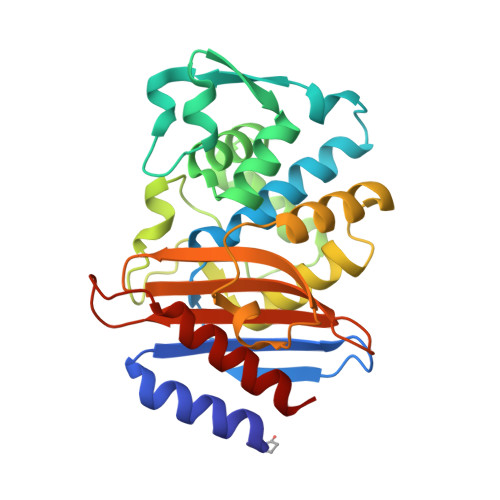Mechanism of proton transfer in class A beta-lactamase catalysis and inhibition by avibactam.
Pemberton, O.A., Noor, R.E., Kumar M V, V., Sanishvili, R., Kemp, M.T., Kearns, F.L., Woodcock, H.L., Gelis, I., Chen, Y.(2020) Proc Natl Acad Sci U S A 117: 5818-5825
- PubMed: 32123084
- DOI: https://doi.org/10.1073/pnas.1922203117
- Primary Citation of Related Structures:
6MZ1, 6MZ2 - PubMed Abstract:
Gram-negative bacteria expressing class A ¦Â-lactamases pose a serious health threat due to their ability to inactivate all ¦Â-lactam antibiotics. The acyl-enzyme intermediate is a central milestone in the hydrolysis reaction catalyzed by these enzymes. However, the protonation states of the catalytic residues in this complex have never been fully analyzed experimentally due to inherent difficulties. To help unravel the ambiguity surrounding class A ¦Â-lactamase catalysis, we have used ultrahigh-resolution X-ray crystallography and the recently approved ¦Â-lactamase inhibitor avibactam to trap the acyl-enzyme complex of class A ¦Â-lactamase CTX-M-14 at varying pHs. A 0.83-?-resolution CTX-M-14 complex structure at pH 7.9 revealed a neutral state for both Lys73 and Glu166. Furthermore, the avibactam hydroxylamine- O -sulfonate group conformation varied according to pH, and this conformational switch appeared to correspond to a change in the Lys73 protonation state at low pH. In conjunction with computational analyses, our structures suggest that Lys73 has a perturbed acid dissociation constant (pK a ) compared with acyl-enzyme complexes with ¦Â-lactams, hindering its function to deprotonate Glu166 and the initiation of the deacylation reaction. Further NMR analysis demonstrated Lys73 pK a to be ¡«5.2 to 5.6. Together with previous ultrahigh-resolution crystal structures, these findings enable us to follow the proton transfer process of the entire acylation reaction and reveal the critical role of Lys73. They also shed light on the stability and reversibility of the avibactam carbamoyl acyl-enzyme complex, highlighting the effect of substrate functional groups in influencing the protonation states of catalytic residues and subsequently the progression of the reaction.
Organizational Affiliation:
Department of Molecular Medicine, University of South Florida, Tampa, FL 33612.





















